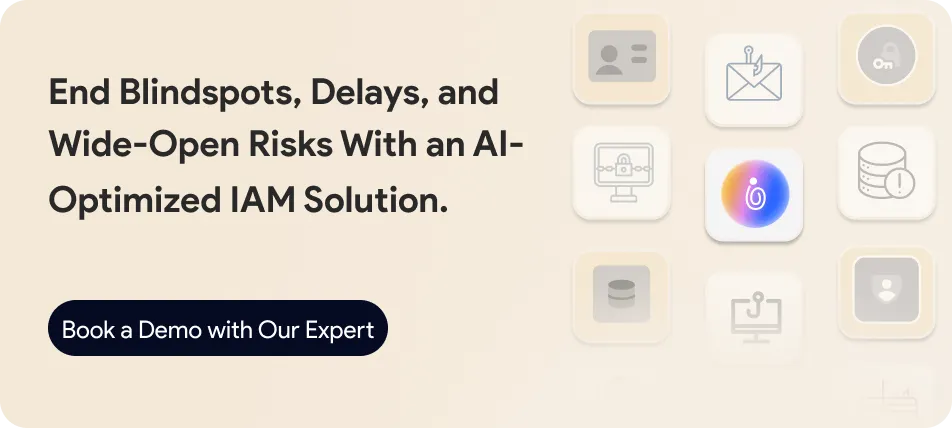In this article, we’ll list some of the best user authentication solutions that not only add security but also improve your user experience!
What is User Authentication?
User authentication is a process where users or employees of specific databases, tools or companies need to prove their identity for access using an authentication framework put in place.
Having user authentication in place prevents unauthorized access, data leaks and breaking compliance laws. However, in order to do it effectively user authentication solutions like an IAM, Workforce Identity Management solution or CIAM software is the ideal choice.
These authentication tools help you grant access, automate the access granting process and keep a track of which users make changes and have access to specific databases.
What are the Types of User Authentication Methods?
- Password or Passcode Based Authentication: Probably the oldest type of authentication in tech - this method requires you enter characters and numbers or combination of both.
- MFA Authentication: MFA is a framework that dramatically improves your security infrastructure. Through this you can enable SMS or Email OTPs, QR codes, a passcode and the use of biometrics for access.
- Token Based Authentication: Token based authentication is a framework mostly used in accessing devices or physical locations. Examples of this would include windows authentication or Apple passkeys.
- Biometric Authentication: This method of authentication requires you use your personal biometric attributes for authentication. This can be a fingerprint, facial recognition, retina scan or even voice recognition.
- Zero Trust Authentication: Zero trust authentication is a type of authentication that requires the user to authenticate themselves at set intervals or on the basis set up in your policy for tighter security. This can be after specific actions or for specific access needs.
- Certificate Authentication: This type of authentication is mostly used for devices or software requesting access to your database. Some examples of this would be SSL/TLS certificates for internet access or authentication for APIs which may be required for specific tasks by users or external contractors.
10 Best User Authentication Solutions in 2025
1. Infisign
Infisign is a cloud-based and on-premises identity management platform that allows user authentication through a zero-trust framework.
Using Zero Trust security and advanced features like passwordless authentication, Infisign adds both safety and user experience by making sure that only verified users gain access to sensitive systems.
With Infisign, businesses can benefit from Privileged Access Management (PAM) to protect assets and prevent unauthorized access. The platform is also easy to use with leading third-party applications.
By adopting decentralized identity frameworks, Infisign helps users control their digital identities, reinforcing security while lowering potential vulnerabilities found in your usual password-based systems.

Infisign’s Key Features:
- Passwordless Authentication: A highly secure alternative to passwords that gets rid of common cybersecurity risks by using biometric or cryptographic authentication methods.
- Zero Trust Security: Makes sure that there is continuous verification of users, devices, and applications, providing real-time security against evolving threats.
- Privileged Access Management: Allows specialized controls to protect user accounts and sensitive data, minimizing insider threats and unauthorized access.
- Decentralized Identity: Uses cutting-edge decentralized identity technologies to give users full control and ownership of their digital credentials.
- Automated Lifecycle Management: Simplifies user access and management tasks, automating the entire lifecycle from onboarding to offboarding.
How Infisign Unified Multiple IdPs for a Global Manufacturing Giant
Infisign acts as a central identity gateway for one of our MAJOR manufacturing clients’ fragmented identity landscape. We removed productivity bottlenecks, security risks, and EXPENSIVE delays.
Infisign unifies the entire ecosystem, bridging disparate directories and tools without replacing costly legacy infrastructure.
How Infisign Helped Our Leading Manufacturing Client:
- Shattered Identity Silos: Created a single source of truth by syncing with all existing IdPs (like Azure AD, Cognito), instantly bridging disparate systems.
- Universal Single Sign-On (SSO) Experience: Delivered a true Single Sign-On experience, authenticating users once for secure, immediate access to every application they need.
- Effortless Legacy App Access: Wrapped decades-old, on-premise applications in a zero-trust security framework, removing vulnerabilities without rewriting a single line of code.

2. Microsoft Entra ID
Microsoft Entra ID is a reliable identity and access management solution that makes sure that there is secure user authentication across various platforms. With it’s advanced features like multifactor authentication (MFA), passwordless login, and adaptive security measures tailored to protect applications and data it makes security more reliable.
Entra ID also supports multiple authentication protocols like OpenID Connect (OIDC) and SAML 2.0, allowing you to work with a wide range of enterprise systems and software. The system allows granular control over authentication methods, boosting security while simplifying user experiences.
Moreover, with support for modern authentication techniques such as FIDO2 security keys and Microsoft Authenticator, Microsoft Entra ID assures you that users have access to both high security and usability.

Features of Microsoft Entra ID
- Multifactor Authentication (MFA): Provides an another layer of security, requiring a secondary authentication method like a text message, push notification, or hardware token, allowing secure user verification.
- Passwordless Authentication: Using biometric factors or Microsoft Authenticator for an easier and secure login process without the need for passwords.
- Adaptive Security: This allows dynamic authentication based on risk analysis, allowing stronger protection in response to unusual sign-in attempts or high-risk scenarios.
- Conditional Access: Tailors access controls based on user location, device state, and other context to safeguard sensitive data and applications.
- Single Sign-On (SSO): SSO Improves user access by allowing sign-ins once for easy access across multiple enterprise applications.
- Support for OpenID Connect and SAML: Allows compatibility with a wide range of legacy and modern applications, allowing flexible usage options for enterprises.
3. IBM Security Verify
IBM Security Verify uses AI and machine learning to calculate risk scores based on contextual factors like user behavior and device characteristics. This allows adaptive authentication, boosting security while creating a smooth user experience.
The system identifies high-risk events and takes necessary actions such as challenging or blocking access, and proactively removing potential threats.

IBM Security Verify’s Features
- AI-Driven Risk Scoring: Continuous risk assessment based on real-time behavior analysis to improve security without disrupting the user experience.
- Passwordless Authentication: Support for passwordless login methods, reducing login issues while boosting security by getting rid of password-related vulnerabilities.
- Hybrid Identity Management: Vendor-agnostic approach for managing both cloud and legacy systems with no-code or low-code solutions, allowing a flexible identity fabric.
- Compliance Support: Helps businesses meet regulatory requirements including HIPAA, PCI DSS, and SOC 2, allowing secure and compliant identity management practices.
- Behavioral and Biometric Risk Scoring: Incorporates advanced biometrics and behavioral analytics for a deeper level of authentication security.
4. Duo
Duo Security combines ease of use with advanced authentication technologies to set a high standard in user protection. By using zero trust principles, it allows all data, devices, and applications to remain secure from evolving cyber threats.
Duo’s MFA improves identity verification using multiple authentication methods, including Duo Push, biometrics, and WebAuthn, creating both flexibility and reliable security.

Duo’s Features:
- Risk-Based Authentication: Adjusts security requirements dynamically based on login behavior, device health, and user location.
- Duo Push Notifications: Quick, real-time access approvals via mobile devices.
- Adaptive Access Policies: With granular access controls, Duo allows that only trusted users and devices gain entry, dynamically adapting to factors like user roles, location, and device health.
- Device Visibility and Trust: Admins gain complete oversight of all connected devices, enabling continuous monitoring of device health and allowing security compliance for network access.
5. Onelogin Workforce Identity
OneLogin Workforce Identity provides companies with a complete solution for securing and managing both internal and external user identities. The platform excels in improving user access with multi-factor authentication (MFA) and identity management capabilities.
It supports Single Sign-On (SSO) to centralize login processes across a wide array of cloud and on-premises applications, gets rid of password fatigue while improving security. With advanced features like SmartFactor Authentication, the solution adapts authentication requirements based on contextual risk factors.
Additionally, OneLogin works with popular directories like Active Directory, Workday, and G Suite, enabling centralized user management.

One Login’s Key Features
- SmartFactor Authentication: Contextual, adaptive authentication based on risk analysis.
- Identity Lifecycle Management: Automates user onboarding and offboarding for better security and operational efficiency.
- Remote Access Security: Helps secure access to both network devices and on-premise applications, like Windows servers and desktops.
6. SecureAuth
SecureAuth is a leading solution in user authentication, that has advanced identity security that meets modern enterprise needs. By combining multi-factor authentication (MFA) with risk-based and passwordless authentication, SecureAuth allows businesses to securely verify user identities with minimal disruption.
This platform creates security by continuously evaluating user behavior and device context, providing fast, invisible MFA. With over 30 MFA methods, including device fingerprinting and biometric verification, SecureAuth meets high industry standards while safeguarding against unauthorized access and fraud.

Key Features of SecureAuth:
- Multi-Factor Authentication (MFA): Provides another security layer beyond passwords, lowering the risk of breaches from compromised credentials.
- Passwordless Authentication: A method that gets rid of passwords for an easier, secure user experience, relying on biometrics or device-specific credentials.
- Invisible MFA: Contextual authentication behind the scenes allows continuous security without adding difficulty, lowering unnecessary authentication prompts.
- Risk-Based Authentication: Evaluates the risk of each login attempt based on factors like user location and device, adjusting security measures accordingly.
- Advanced Analytics: Uses machine learning to improve threat detection and decision-making by analyzing user behavior and environmental data.
7. CrowdStrike
CrowdStrike allows a unified solution for securing identities across hybrid environments, allowing real-time threat detection and protection for both cloud and on-premises identities. With the use of advanced AI and machine learning, CrowdStrike detects and stops identity-based threats by monitoring behaviors and identifying anomalies.
By combining endpoint and identity security, CrowdStrike makes sure there is complete visibility, allowing for fast response to attacks like lateral movement and credential theft. The platform’s MFA usage extends protection to legacy systems and cloud platforms alike, boosting security while preserving user experience.

CrowdStrike Identity Protection’s Features:
- Real-Time Threat Detection: Uses AI to detect and neutralize identity threats before they can cause damage.
- Unified Security for Hybrid Environments: Supports protection across Active Directory, Entra ID, Okta, and more, making sure that there is visibility across various identity stores.
- Multi-Factor Authentication (MFA): Simplifies MFA across both modern and legacy systems, extending coverage and reducing attack vectors.
- Advanced Machine Learning Analytics: Automatically assesses user behavior and identifies suspicious activity to prevent identity-based attacks.
- Easy Integration: Easily works with existing security infrastructures, including SIEM and SOAR, for a cohesive security strategy.
8. RSA SecurID
In a world where security breaches are commonplace, protecting user access is essential for building trust. RSA SecurID is a reliable solution for user authentication across both cloud and on-premises systems.
This software not only stregthens security but also lowers any difficulty in the user experience, making it easier for users to authenticate without compromising on safety.
For companies handling sensitive data, RSA SecurID provides a flexible and scalable solution that adapts to a range of security needs. From your usual hardware tokens to passwordless authentication, it allows secure access to applications, VPNs, and cloud services. Some of these include software like Microsoft 365, and it does this while maintaining compliance with industry standards.

RSA SecurID’s Features
- Push Notifications: Allows users to authenticate quickly through secure approval requests sent to their devices.
- Mobile App Authentication: Has various authentication methods, including OTP and biometric authentication, making sure that there is flexibility without compromising security.
- Hardware Tokens: Generates time-based, one-time passcodes (TOTP), adding a physical layer of security for users.
- Passwordless Authentication (FIDO): Gets rid of the need for passwords by using industry-standard FIDO technology for streamlined, secure access.
9. PingOne
PingOne is a highly scalable identity and access management (IAM) solution designed for enterprises, The software creates a secure and easy user authentication experience across multiple platforms that cohesive.
With its advanced Multi-Factor Authentication (MFA) capabilities, PingOne supports passwordless login, using modern standards like FIDO2 for biometric authentication, passkeys, and security keys.
This not only improves security by removing the risks of password theft but also improves the user experience by lowering the need for your usual password inputs.
Adaptive authentication uses contextual data like device status, location, and behavior patterns to apply real-time risk analysis, allowing more granular control over access decisions.

PingOne’s Features
- Passwordless Authentication: Uses FIDO2 standards, including biometrics and passkeys, to add security and user convenience.
- Multi-Factor Authentication (MFA): Incorporates various methods like push notifications, SMS, and email-based OTPs to add extra layers of security.
- Single Sign-On (SSO): Simplifies login by allowing users to access multiple applications with a single authentication process, simplifying user management and access control.
- Adaptive Authentication: Analyzes real-time risk data such as location, device, and user behavior to adjust security measures dynamically.
- Advanced Risk Management: Work with policy management to provide real-time alerts and risk evaluations, empowering administrators to make informed access decisions.
10. JumpCloud
With an ever-growing focus on IT security, platforms like JumpCloud are rising as a solution for user authentication, access control, and device management. JumpCloud goes beyond your usual user authentication methods by unifying cloud identities, allowing both flexibility and security across diverse environments.
Designed to have multi-factor authentication (MFA) options, JumpCloud helps protect against unauthorized access while simplfying the authentication process across devices and applications. The platform’s centralized directory services simplify identity management for distributed teams, securing access from virtually anywhere.

JumpCloud’s Features
- Cloud Identity Management: Centralized user management across all platforms, from internal systems to third-party applications and devices.
- Multi-Factor Authentication (MFA): Better login security through multiple authentication factors, supporting biometrics, hardware tokens, and mobile-based authentication methods.
- Secure Access: Conditional access controls to follow security policies based on user location, device compliance, and other contextual factors.
- Directory-as-a-Service: Provides a cloud-based directory service to manage users, devices, and access across a variety of platforms without relying on your typical on-premises infrastructure.
- Single Sign-On (SSO): Facilitates secure, easier access to multiple applications with a single set of credentials, improving user experience and lowering password fatigue.
What are the Key Features of User Authentication Solutions That Improve User Authentication?
Multiple Authentication Methods
User authentication solutions that support multiple authentication methods cater to a variety of security needs. This flexibility allows businesses to choose from a range of options, such as password-based, biometric, and multi-factor authentication, based on user risk profiles and contextual factors.
For instance, users may be required to complete a biometric scan or a one-time password (OTP) verification when accessing sensitive data. This adaptable approach strengthens overall security while maintaining ease of access for users across different platforms and devices.
Single-Sign-On Framework
With SSO, users no longer need to remember and manage multiple passwords for different platforms, reducing the likelihood of weak passwords.
From a security standpoint, SSO reduces the surface area for potential breaches, as fewer credentials are needed. Additionally, it simplifies the authentication process, reducing administrative overhead and improving user productivity. Real-time authentication data can also be accessed from centralized logs, aiding in monitoring and compliance.
Automated Reports and Logs
User authentication solutions equipped with automated reporting and logging capabilities simplifies the monitoring and auditing of access attempts. These systems generate detailed logs of all authentication activities, including successful and failed login attempts, time stamps, and IP addresses, making it easier to track any potential security threats.
These logs can be used for troubleshooting, compliance reporting, and identifying patterns that suggest suspicious activity, improving security without manual oversight. Automated reporting reduces administrative overhead and provides real-time insights into authentication processes.
Conditional Access and Adaptive Authentication
Conditional access and adaptive authentication within user authentication solutions evaluate various factors such as device type, location, and user behavior before granting access. By using risk-based decision models, these solutions can adapt the authentication process based on the context of the access attempt.
This dynamic approach allows for stronger authentication methods, such as multi-factor authentication, when risks are high, and lighter methods when risks are low. As a result, user access is continuously protected without compromising the user experience.
Suitability for On-Premises and Cloud Environments
User authentication solutions that cater to both on-premises and cloud environments allow flexible access control across hybrid systems. By allowing support for both settings, these solutions allow for centralized authentication without disrupting existing workflows.
For on-premises setups, the solution can manage local credentials, while in cloud environments, it can handle federated identities and cloud-specific protocols. This dual support allows administrators to maintain consistent security policies regardless of where the user’s data resides, whether on-premises or in the cloud.
Directory-Sync
Directory sync within user authentication solutions improves how companies maintain consistent user data across multiple systems. By synchronizing directories, such as Active Directory, with authentication systems, user credentials are automatically updated, makes sure that access permissions reflect the most current information.
This reduces manual data entry errors and makes sure that users are granted the appropriate access based on their most recent status. Moreover, directory-sync allows for faster user onboarding and offboarding, bettering operational efficiency.
Why Make Infisign Your Company’s User Authentication Solution?
User authentication in your company needs to secure and effortless - which is why choosing Infisign is a choice that can add immense value to your security framework. With automated provisioning and deprovisioning, Single-Sign On frameworks and even AI Access Assist, Infisign makes granting and monitoring access throughout your company straightforward. Aside from reducing admin costs, it also comes with passkeys and directory-sync without any unnecessary hidden costs - which is how it is with most software! Want to know more? Why not reach out with our technical team for more information.




.webp)

















